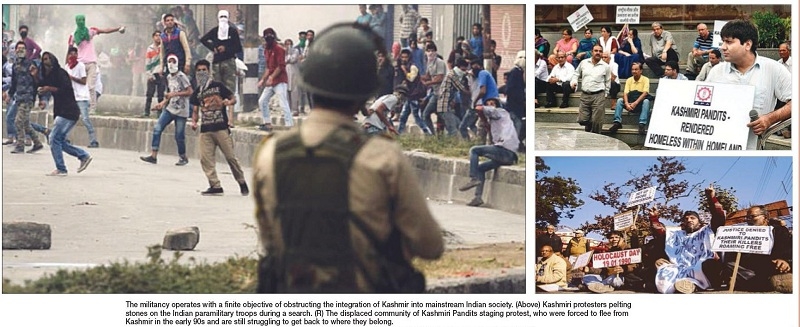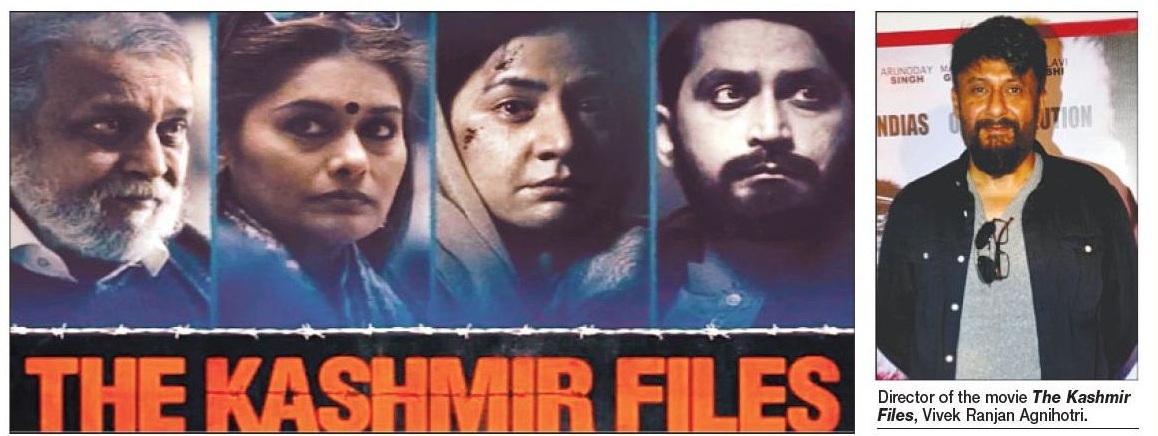KASHMIR RILES
| Date :03-Apr-2022 |

By VIJAY PHANSHIKAR :
A blood-curdling scream shattered the calm stillness of the cold night, shaking everybody in the neighbourhood out of slumber. And then everything fell silent. No stirring. No movement, except the sound of hurrying steps crunching on the gravel on the road. The next morning, however, brought to light two mutilitated and almost naked bodies -- one of a woman and the other of a man -- with blood having dried on their torn skins. They were such a fine couple, very friendly, very helpful, very amiable -- the picture of their fine culture. The whole neighbourhood, populated mostly by people from the Kashmiri Pandit community, interspersed by some from other communities. The violence just shattered the small community that had lived together for ages. Police came -- and went.The grief-stricken and terribly shocked family and neighbours completed the funeral formalities. Beyond that, nothing happened. That was towards the mid-1980s, and locale was somewhere in urban outskirts of Kashmir. In the next few moths and years, such incidents took place repeatedly increasing numbers -- creating scare among the members of the Kashmiri Pandit community. The police often showed up -- and vanished, doing nothing.

A well-planned community purge was gaining momentum -- with no redressal in sight, with no one to listen to the plight of the people whose homes were attacked -- mostly during the night hours -- by socalled terrorists. These incidents would soon turn into a torrent, with hordes of goons pouncing upon the generally well-to-do, peaceloving Pandit community. Men were tied down or killed, women were raped, children were thrown out of windows, and lastly the houses were set on fire. Before long, the terror spread so deep and wide that countless numbers of Kashmiri Pandit families began fleeing their homes and hearths where they had lived for generations, taking shelter wherever possible across the vast Indian landscape, living like refugees in their own land. Educated among them got jobs and work opportunities, while many others reeled under terrible conditions.
By end-1989, the fleeing of the Pandit community has assumed the form of a massive exodus. According to some estimates, at least half a million of Kashmiri Pandits fled their places and took shelter elsewhere -- possibly never to return. Not far away in Srinagar, Jammu and Kashmir Chief Minister Dr. Farooq Abdullah sat playing part-political and part-separatist fiddle while the Pandit community burned -- actually and metaphorically. This story is too well known to be told again -- particularly after the movie The Kashmir Files. The sad part, however, is that the Indian nation, the larger Indian society, gave only a cold response or reaction to what may be safely described as genocide of shocking proportions. This scribe wrote on countless dozens of times on the plight and flight of the unfortunate Kashmiri Pandit community. He also raised the issue at local, national, and international platforms in whatever way he could. Leave alone what reactions came at the international events, the reactions at the local or national events did not elicit much response, except a mild sense of disgust -- and even disbelief. Beyond that, everything was placid. Of course, some alert organisations did their best to help the distressed Kashmir Pandits. But little was actually done to protect the community from barbarism unleashed by so-called terrorists as well as local goon gangs -- whose ranks even neighbours joined.
Even the media turned generally a blind eye to the genocide. Some voices, of course, kept on telling the gory story again and again. Some of those voices were also from Kashmir, having seen the gore themselves. They did create ripples in the society to an extent. Otherwise, the society slumbered. Then came the movie -- after decades of the strange indifference and silence, and through much opposition from the Bollywood mughals.The society woke up -- as if the society had never heard the screams from Kashmir. There could never be a greater societal fraud than this. The society slept -- as if deliberately -- and then woke up -- feigning ignorance! -- as if it needed a film to wake it up. This was a fraud the society played upon itself. Or possibly, the society was kept in the dark about what happened to the Kashmiri Pandit community. For, even Pallavi Joshi (wife of movie Director Vivek Ranjan Agnihotri, and an actress of eminence in her own right) confessed that she did not know anything about the genocide before her husband started working on the details. Even though her statement could be believed to be honest, it is still difficult to be told that the larger Indian society did not know absolutely anything about the atrocities on Kashmiri Pandits.
There is no doubt that The Kashmir Files must be a truly well-made film; which is why it is attracting tremendous audiences and superb popular response. And as a natural consequence, it also has attracted much criticism, driven mostly by political vested interests. Let us leave the film alone, per se. Let us focus on the issue that riles Kashmir. Let us understand the nature of infliction that Kashmir suffered from. Let us develop a truthful perspective. One of the criticisms that the film aims to divide the larger society, and so it needs to be banned.That hardly makes any sense. For, such films have been made all over the world highlighting deadly truths from history -- and no society was ever divided by their screening. The critics also say that not just the Kashmiri Pandits, but also the Muslims suffered in the genocide. That may be true, to an extent. But then, why did that part of the story, too, did not come to light? Knowing the nature of the Muslim community culture, it is beyond imagination that the community did not react angrily all over the place when their brethren were being subjected to untold cruelty by terrorists.
Or, can it mean that the Muslim community did not mind some of its own members in Kashmir being butchered by terrorists (who swore by Islam)? I t is time we left behind the political narrative and understand the reality of Kashmir. It is time we acknowledged that when the community purge began, even local non-Pandit people also joined the goons. Terrible tales of high school students sexually attacking their teachers who lived in the neighbourhood are common knowledge from the genocide -- which was until now described only as exodus. The cruelty, the attacks on the Kashmiri Pandit community people have now been proved to be parts of a big conspiracy hatched by elements that believed in such purges as part of their historical valuesystem, showing a pattern of sorts. When the British were contemplating India’s Partition, years before 1947, Bengal of those times saw a terrible orgy of violence, unleashed by some leaders (like Huseyn Shaheed Suhrawardy, Chief Minister of United Bengal) had declared “Direct Action Day” that brought in untold communal violence on members of the Hindu community. That fetched an equal and opposite reaction from the other side. The idea behind the Direct Action Day was clear: Divide the society, demolish social harmony to such an extent that a subsequent unity would look impossible. So, the country needed to partition, those elements argued.
In Kashmir, under the cloak of Special Status, all such ideas were tried -- so that Kashmir slips out of India’s grip. Of course, all those were stupid ideas and proved useless, thanks to the mature manner in which India handled the situation, and finally abrogated Special Status to effect a complete integration of Kashmir with the rest of the country. U sually, January, 1990, is considered to be the time by which the Pandit community fled Kashmir. But there was no question of any cut-off date as such. For, the fleeing started sometime in the middle of 1980s and continued for the next some years. During this long stretch of time, violence continued in all its terrible proportions. And the Government -- in Srinagar and in New Delhi -- slipped into a political slumber, almost deciding to look the other way. None in both the places carried a sense of shame, a sense of national responsibility, a sense of loyalty to every citizen and his security. The shameless manner in which the Government in general ignored the purge was actually criminal in nature, no matter who was at the helm in New Delhi or in Srinagar.
A succession of Prime Ministers ignored the gory story of the Pandit community, only occasionally mouthing a word of sympathy. But there was no empathy -- as if that indifference was politically expedient for the people in power. What a national shame! The film The Kashmir Files may have brought out one aspect of the dirty, gory happenings in Kashmir in certain bracket of time. But the story of Kashmir’s rot was the outcome of rotten policies adopted by those in power for long years. It was a deliberate, anti-national rot in which every kind of atrocity was perpetrated in the minority Hindu community in Kashmir -- as if the blueprint of the systematic violence had come from the neighbouring Pakistan where, too, the Hindu community has been reduced from a respectable 24 per cent in 1947 to less than 2 per cent now. In Kashmir, too, a similar mindset was operating for decades. The stress was on ‘direct action’, that meant violence, terror, and horror. The stress was afflicting minority communities with a sense of impossibility of living in Kashmir.
That was the purge the genocide of Kashmiri Pandit community represents. The movie The Kashmir Files brings out only one dirty chapter in the Kashmir story. But the whole story is as gory as this part is. And those who masterminded such violence were certainly responsible for this state of affairs. But equally, or more, responsible was the Government at different levels and places in India. True, some corrections are now underway in Kashmir. Yet, it is not possible to visualise accurately how things will shape up in the next some time. For, there is no idea how the Government plans the rehabilitation of the displaced Kashmiri Pandits back in their original homes. Nobody knows when that point in time will come -- if it really does. For at least until now, the nation has not known any concrete plan for the return of the Pandit community people to their homes in the near future. That is where Kashmir hurts -- as it does also at many other places